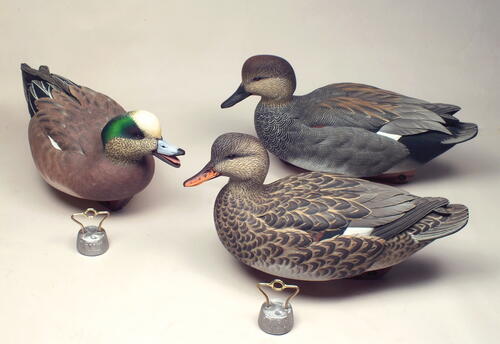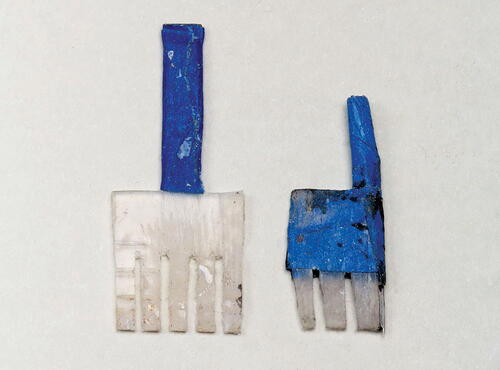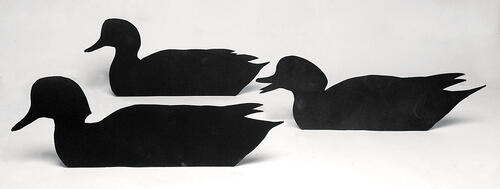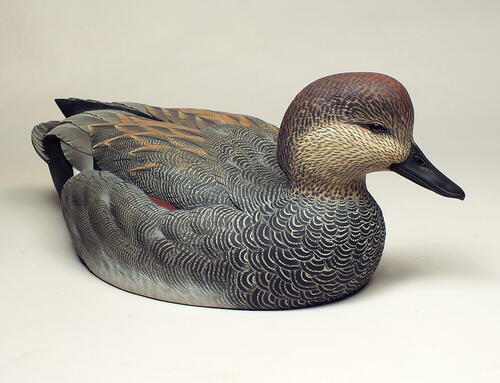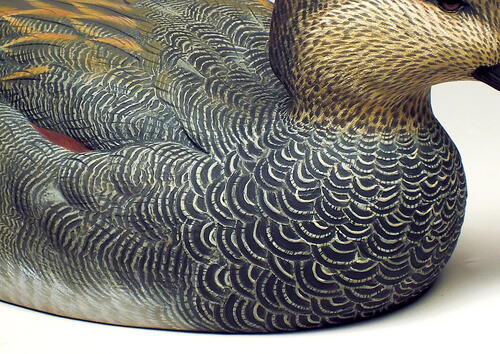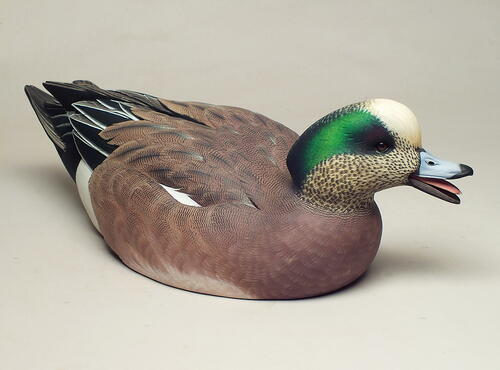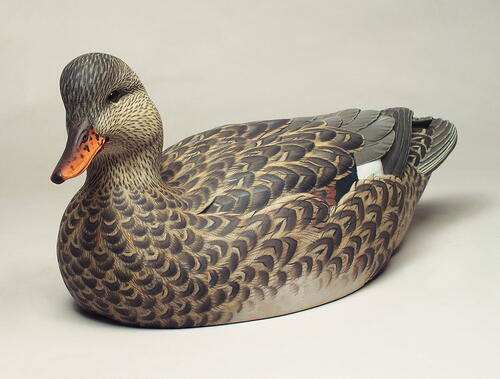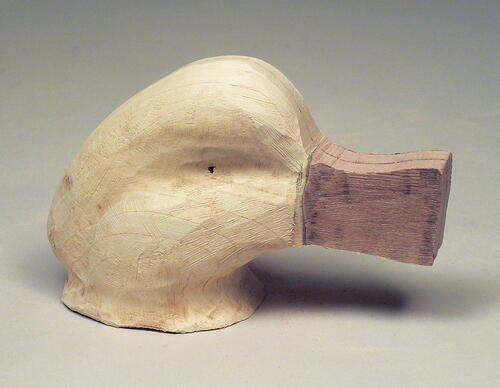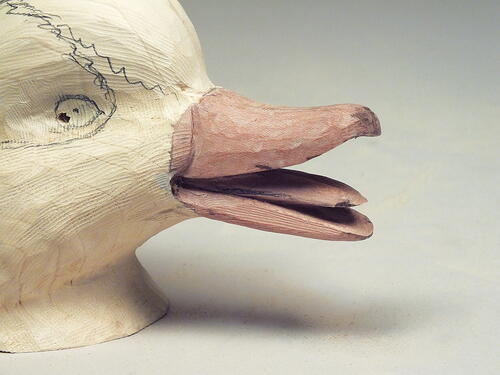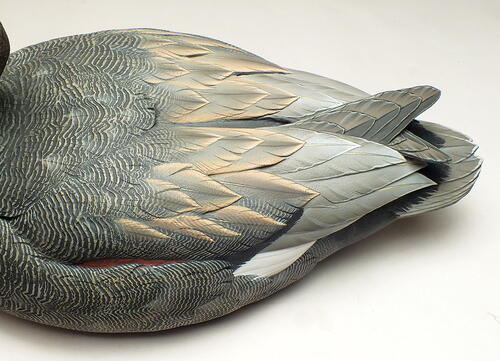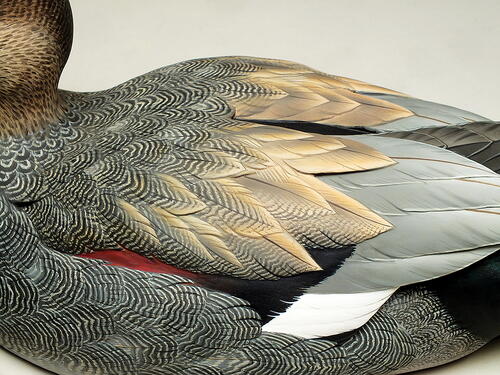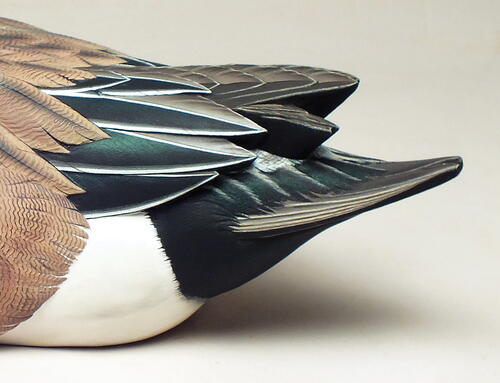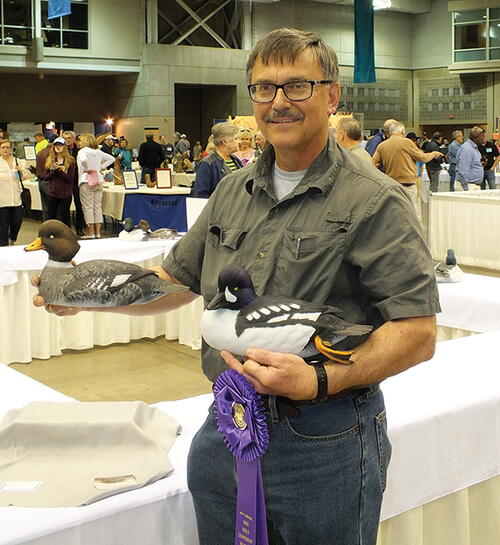Composition Is Key
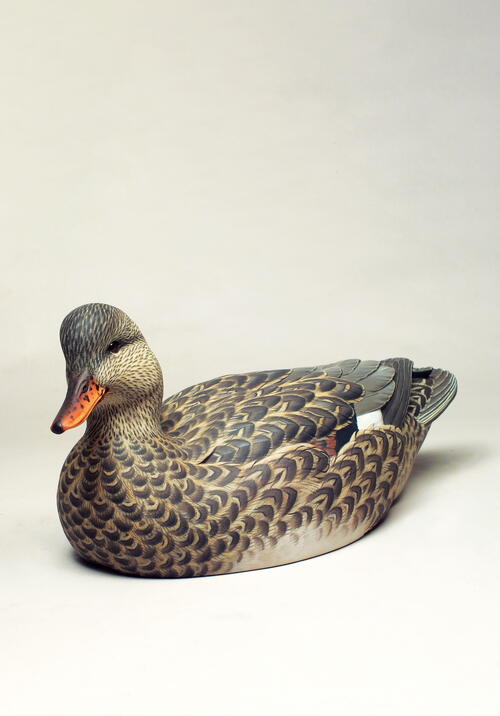
After deciding on the composition of my World Shootin’ Rig entry into the 2013 Ward World Championship, I was eager to begin the construction. The species were a pair of gadwalls with an American wigeon drake. In nature, these two species are often seen together in mixed flocks due in part to a similarity in their diets and range. Rather than make a rig with three gadwalls, I felt that including the wigeon would add color and contrast to make things more interesting.
To model the three birds in the rig, I tried something I had never done before. Initially, for each bird, I made different versions of side profiles in two dimensions, tracing them onto thin cardboard, cutting them out, and painting them black. Putting the silhouettes together helped me visualize the composition. I did not need to see colors or detail; in fact, by eliminating these distractions, the best composition was perhaps easier to develop.
The gadwall drake, also known in Louisiana as the gray duck, for obvious reasons, is a bird of low contrast and a lack of brilliant color. What is so appealing to me are the patterns created by the fairly coarse vermiculation and the crescent-shaped breast markings. From a distance, all this detail projects as a dark gray. For a true gunning decoy, these regions could just be painted gray with no detailed pattern. For the World show, however, I definitely had to create the painted patterns.
I used combing techniques for both the vermiculation and breast markings. I knew I had to incorporate variety in the vermiculation and ended up using a medium-spaced comb for the finest patterns and a custom-made comb for the coarse vermiculation. This comb was used over a large portion of the back as well as in the transition between the breast markings and the vermiculated region of the side feathers. The unique patterns of the breast feathers required a specific comb designed to match the feathers of the real bird.
On this bird, the transition is very gradual and presents one of the piece’s biggest challenges. If handled with skill and experience the combing technique can result in an amazingly realistic effect. In most other species, when employing a combing technique, I start with a light background and scrub dark paint onto the tops of the three-dimensional pattern. However, with the gadwall, the end result must be quite dark, so the most logical approach was to start with a dark background color and scrub the light onto the combed pattern. I have also hand-painted the vermiculation on other carvings of the gadwall drake using a fine kolinsky sable brush, a much more time-consuming method. On these birds, I used the same approach, brushing the light pattern over a dark background.
The head of the gadwall drake shows a cryptic pattern similar to that of many marsh duck hens. An interesting detail is a subtle violet iridescence in the pattern behind the eye. On such a drab overall color scheme I look for features such as this that I can use to create points of interest. The white wing speculum is another such feature. Forward of that, the wing coverts are a deep, rich red; the arrangement of the side feathers shows off a tiny bit of these feathers.
Gadwall hens are frequently mistaken for mallard hens. Their color schemes are very similar. The mallard hen is an overall richer color with more reddish tones in the feathers, but the general pattern of the dark body feathers with light edges and V-shaped internal markings is almost identical. Of course, the gadwall’s white wing speculum is a distinguishing feature. To highlight this, I composed the side feathers to show off the speculum.
The design includes subtle animation in the head, which is tilted so the bird appears to be looking upward to its left, perhaps toward an avian predator. To make this look accurate, I made sure to tilt the head at the base of the skull location, not at the lower region, where the neck meets the breast.
For the wigeon drake, I created an aggressive scolding posture. I had already made a fully decorative wigeon drake with this design, although it was delicate, with inserted primary flight feathers, thinned tail, lots of feather undercuts, hand-brushed vermiculation, and finely burned and textured feather barb detail. On the rig wigeon, I combed the vermiculation and, besides taking much less time to complete, the final result projects just as well as the hand-brushed vermiculation.
Even though the category requires that the decoys be durable, and so the tails must be thick, I wanted to create an optical illusion to make the tail look thin. The tails of most birds are usually light in value, so when I paint the tail feathers, because the tail must have additional thickness, I paint the excess wood below the light edge of the feathers dark. When viewed from a distance, the light-colored tail is very visible whereas the dark excess wood basically disappears. All three of these birds in this rig are great examples of this illusion.
This piece placed second in the World Shootin’ Rig category, alongside Tom Christie’s first-place scaup rig and Jeff Krete’s third-place buffleheads.
Images
-
Designing a gadwall and wigeon rig as a work of art!
-
The comb at left was custom-made for the transition between the breast markings and the finer vermiculation of the side feathers. For the breast markings, the spacing on the comb at right matches the patterns. To create perfect circular patterns the tip of a needle is exposed at the base of the comb, which serves as an anchor in the wood. The comb pivots at this point like a circle compass. I learned about this pin detail innovation from one of my students, Gerry Glaves. My students are often a great source of knowledge and inspiration.
-
Modelling was accomplished by creating several two-dimensional profiles for each bird and then deciding on the best composition of the rig. Compared to the three-dimensional clay models I make for my decorative decoys and other birds, this method is a quick and very effective way to visualize how the finished rig will project in the water
-
The gadwall drake sports coarse vermiculation and crescent-shaped breast markings.
-
Careful combing techniques enabled the reproduction of the drake’s complex markings
-
The posture of the scolding drake was carefully composed so the piece would project well on the open water
-
The head of the gadwall hen was tilted upward. The point of articulation must be at the base of the head, not at the lower neck region.
-
To ensure strength in the open bill of the wigeon drake a piece of cornel dogwood was inserted into the block of tupelo before cutting out the profile of the head. At that point the head was shaped in traditional fashion.
-
Hand-brushed and combed vermiculation both give excellent results. The former is more time consuming but will also be more precise and accurate.
-
The illusion of a very thin tail was created simply by using carbon black to paint the excess wood below the edge of the light tail feathers.
-
Pat Godin has accumulated 17 World titles spanning five decades, with wins in four of the five World categories of the Ward World Championship. In 2015, he was named a Living Legend by the Ward Museum. He is an active competition judge and carving instructor who has developed numerous resources for carvers, including his popular Championship Waterfowl Patterns series. He lives in Paris, Ontario.


